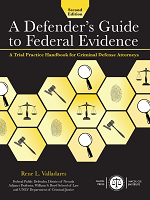Washington, DC (July 7, 2005) – Speaking at the National Center for Victims of Crime in Washington, D.C. on June 21, Attorney General Alberto Gonzales sharply criticized federal sentencing practices since the Supreme Court handed down its opinion in United States v. Booker, 125 S. Ct. 738 (2005) last January.1 The Attorney General expressed concern that the now-advisory guidelines had resulted in a “drift toward lower sentences” resulting in the loss of a “critical law enforcement tool.” He said he would support legislation that would strictly limit judicial discretion to sentence below the guideline range, but allow judges free rein to sentence above it.
The Attorney General cited four cases which he believes illustrate his contention that defendants are “receiving sentences dramatically lower than the guidelines range without any explanation, or on the basis of factors that could not be considered under the guidelines.” A fact sheet released today by the National Association of Criminal Defense Lawyers concludes that the Attorney General has been misinformed about federal sentencings since Booker.
Defense lawyers analyzed the four cases cited by the Attorney General and determined that none of those cases reflect failures of the judiciary or the current federal sentencing system. On the contrary, in each case the judge imposed a facially-reasonable sentence sufficient, but not greater than necessary, to achieve just punishment, deterrence, and protection of the public in accordance with the Sentencing Reform Act of 1984.
The report released today provides a complete description of each case cited by the Attorney General in his remarks, based on public documents, sentencing transcripts and interviews with counsel.
For example, the Attorney General expressed concern that a New York defendant facing a presumptive sentence of 27 to 33 months in prison for possessing child pornography on his computer received “only probation” while a New Jersey defendant received 41 months.
- The fact is that the New York judge had one primary concern: protection of the public. Studies show that sex offender treatment cuts recidivism by more than half, but the Federal Bureau of Prisons has only 112 beds in its sex offender treatment program, and as a result, only 1 percent of sex offenders in federal prison receive intensive treatment while incarcerated. At the time of his sentencing, the New York defendant had already been in a highly structured residential treatment program for 18 months at his own expense , which he has covered by selling his home. The residential program includes counseling, psychiatric treatment, group therapy and 12-Step meetings. The judge conditioned the defendant’s 5 years of probation on his continued residential treatment followed by a structured halfway house environment. Failure to continue with treatment and abide by other conditions of probation would result in imposition of a sentence of incarceration. The judge had before him a record of successful residential treatment over an 18-month period, but no evidence before him of what, if any, treatment the defendant would receive if incarcerated. The judge found that continued residential treatment would best reduce the likelihood of recidivism and protect the community. The government did not appeal that sentence.
Another case that disturbed the Attorney General supposedly involved a 70-year-old defendant with a gravely ill wife who had no relatives in the United States and no means of financial support other than the defendant. According to the Attorney General, he was sentenced for “evading the payment of more than six million dollars in taxes” and had “petitioned the court for resentencing” after Booker.
- The judge actually found that the value of the assets the defendant sought to conceal – the “tax loss” to the government – was just over $1.2 million. Moreover, the Supreme Court decided Booker while the defendant’s case was on appeal, and the U.S. Court of Appeals automatically remanded the case to the trial court for resentencing, as it did with scores of other cases in that circuit. The defendant was sentenced to seven months’ incarceration followed by seven months’ home detention, followed by three years of supervised release.
In the case of the Kansas rancher convicted of bank fraud, the Attorney General said that the rancher got $1.8 million in cattle loans, “falsely claiming that he was using the money to buy live cattle.” The AG went on to say that “the judge gave him probation only, reasoning, in part, that the defendant had suffered enough when the bank foreclosed on his house.”
- The sentencing judge found that the rancher was himself the victim of a confidence artist who proposed to store cattle on the defendant’s ranch if he would expand his operation. The defendant took out the loan to finance the expansion and to buy cattle of his own. A “statement of fact” prepared by the Justice Department prosecutor in the case and filed with the court, reveals that the defendant did purchase 4,000 head of cattle, contrary to the Attorney General’s information. The con man failed to come through with any cattle and depleted the loan proceeds. Realizing the man was a fraud and that he was not going to be able to repay the loan as planned, the defendant played the cattle futures market in the hope of repaying the bank loan. The court gave six carefully explained reasons for the sentence of one day plus a period of probation – none of which was that the defendant had “suffered enough when the bank foreclosed on his house.” More importantly, documents from the case show that the judge ordered the defendant to make restitution to the bank; conditions of his supervised release include restitution, disclosure of all financial information to the probation office, and a prohibition against future borrowing without advance approval. As of this date, the defendant has made all the required restitution payments. The government did not appeal that sentence.
In the fourth case, the Attorney General said that a defendant in South Carolina had received "only" ten years in a case in which he faced over 27 years.
- The defendant in this case was arrested at age twenty in his home with a relatively small amount of cocaine and marijuana, as well as several firearms. He had had an exceedingly difficult upbringing, but had shown some ability to overcome it by obtaining a GED and working in a barbershop. The defendant did not face 27 years. By operation of the severe "Career Offender" guideline, his guideline sentence went from a minimum of 84 months to a minimum of 188 months, based on his conviction for failing to pull over when signaled by a police officer, a non-violent misdemeanor under South Carolina law, when he was seventeen years old. The judge imposed 120 months'' incarceration, including a recommendation to the Bureau of Prisons'' drug treatment program and education in a marketable skill, followed by six years'' supervised release including drug treatment and drug testing.
Copies of the report may be obtained by clicking here.
________________________________________
- See “Prepared Remarks of Attorney General Alberto Gonzales, Sentencing Guidelines Speech,” Washington, D.C, July 21, 2005 (available online at http://www.usdoj.gov/ag/speeches/2005/06212005victimsofcrime.htm).
Contacts
NACDL Communications Department
The National Association of Criminal Defense Lawyers is the preeminent organization advancing the mission of the criminal defense bar to ensure justice and due process for persons accused of crime or wrongdoing. A professional bar association founded in 1958, NACDL's many thousands of direct members in 28 countries – and 90 state, provincial and local affiliate organizations totaling up to 40,000 attorneys – include private criminal defense lawyers, public defenders, military defense counsel, law professors and judges committed to preserving fairness and promoting a rational and humane criminal legal system.






